Discovering Spatial-Temporal Indication of Crime Association (STICA)
Abstract
:1. Introduction
2. Spatial-Temporal Analysis Methods in Place-Based Crime Research
3. Materials and Methods
3.1. Theoretical Basis of the STICA Approach
3.2. General Framework of the STICA Approach
3.3. An Implementation of the STICA Approach
3.3.1. Dataset Representation
3.3.2. Progressive Clustering Analysis
3.3.3. Thematic Mapping and Analysis
3.4. Study Area and Data
4. Results and Discussion
4.1. Estimating Monthly Kernel Density of Burglary
4.2. Discriminating Temporal Types and Spatial Hierarchies of Factors with the STICA Approach
4.3. Identifying and Understanding the Main Factors of Crime with the STICA Approach
4.3.1. Identifying and Understanding Time-Stable Factors of Crime with the STICA Approach
4.3.2. Identifying and Understanding Time-Varying Factors of Crime with the STICA Approach
5. Conclusions
Author Contributions
Funding
Data Availability Statement
Acknowledgments
Conflicts of Interest
References
- The Oxford Handbook of Criminological Theory; Cullen, F.T.; Wilcox, P. (Eds.) Oxford University Press: New York, NY, USA, 2013. [Google Scholar]
- Shaw, C.R.; Mckay, H.D. Juvenile Delinquency and Urban Areas: A Study of Rates of Delinquency in Relation to Differential Characteristics of Local Communities in American Cities; University of Chicago Press: Chicago, IL, USA, 1942. [Google Scholar]
- Eck, J.E.; Weisburd, D. Crime and Place; Criminal Justice Press: Monsey, NY, USA, 1995. [Google Scholar]
- Guerry, A.M. Essai Sur la Statistique Morale de la France; Crochard: Paris, France, 1833. [Google Scholar]
- Harries, K.D. The Geography of Crime and Justice; McGraw-Hill: New York, NY, USA, 1974. [Google Scholar]
- Lebeau, J.L.; Leitner, M. Introduction: Progress in Research on the Geography of Crime. Prof. Geogr. 2011, 63, 161–173. [Google Scholar] [CrossRef]
- Liu, L.; Eck, J. Artificial Crime Analysis Systems: Using Computer Simulations and Geographic Information Systems; IGI Publishing: Hershey, NY, USA, 2008. [Google Scholar]
- Quetelet, M.A. A Treatise on Man and the Development of His Faculties; William and Robert Chambers: Edinburgh, UK, 1842. [Google Scholar]
- Weisburd, D.; Bernasco, W.; Bruinsma, G.J.N. Putting Crime in Its Place: Units of Analysis in Geographic Criminology; Springer: New York, NY, USA, 2009; pp. 1–254. [Google Scholar]
- Chainey, S.; Ratcliffe, J. GIS and Crime Mapping; John Wiley and Sons: Hoboken, NJ, USA, 2005. [Google Scholar]
- Sherman, L.W.; Gartin, P.R.; Buerger, M.E. Hot Spots of Predatory Crime: Routine Activities and the Criminology of Place. Criminology 1989, 27, 27–56. [Google Scholar] [CrossRef]
- Ratcliffe, J.H. The Hotspot Matrix: A Framework for the Spatio-Temporal Targeting of Crime Reduction. Police Pract. Res. 2004, 5, 5–23. [Google Scholar] [CrossRef]
- Sherman, L.W.; Weisburd, D. General deterrent effects of police patrol in crime “hot spots”: A randomized, controlled trial. Justice Q. 1995, 12, 625–648. [Google Scholar] [CrossRef]
- He, L.; Páez, A.; Liu, D. Persistence of Crime Hot Spots: An Ordered Probit Analysis. Geogr. Anal. 2016, 49, 3–22. [Google Scholar] [CrossRef] [Green Version]
- Weisburd, D.; Telep, C.W.; Braga, A.A. The Importance of Place in Policing—Empirical Evidence and Policy Recommendations; The Swedish Crime Prevention Council: Stockholm, Sweden, 2010. [Google Scholar]
- Townsley, M. Visualising space time patterns in crime: The hotspot plot. Crime Patterns Anal. 2008, 1, 61–74. [Google Scholar]
- Nagin, D.S. Analyzing Developmental Trajectories: A Semiparametric, Group-Based Approach. Psychol. Methods 1999, 4, 139–157. [Google Scholar] [CrossRef]
- Weisburd, D. Place-Based Policing. Police Found. 2008, 9, 1–16. [Google Scholar]
- Johnson, S.D.; Bowers, K.J. The Stability of Space-Time Clusters of Burglary. Br. J. Criminol. 2004, 44, 55–65. [Google Scholar] [CrossRef]
- Johnson, S.D.; Lab, S.P.; Bowers, K.J. Stable and Fluid Hotspots of Crime: Differentiation and Identification. Built Environ. 2008, 34, 32–45. [Google Scholar] [CrossRef]
- Mohler, G.O.; Short, M.B.; Brantingham, P.J. The Concentration-Dynamics Tradeoff in Crime Hot Spotting. In Unraveling the Crime-Place Connection; Weisburd, D., Eck, J.E., Eds.; Routledge: New York, NY, USA, 2017; pp. 19–39. [Google Scholar]
- Cohen, L.E.; Felson, M. Social Change and Crime Rate Trends: A Routine Activity Approach. Am. Sociol. Rev. 1979, 44, 588. [Google Scholar] [CrossRef]
- Eck, J.E. Examining routine activity theory: A review of two books. Justice Q. 1995, 12, 783–797. [Google Scholar] [CrossRef]
- Brantingham, P.B. Nodes, Paths, and Edges: Considerations on the Complexity of Crime and the Physical Environment (1993). Class. Environ. Criminol. 2010, 13, 289–326. [Google Scholar] [CrossRef]
- Cohn, E.G.; Rotton, J. Even criminals take a holiday: Instrumental and expressive crimes on major and minor holidays. J. Crim. Justice 2003, 31, 351–360. [Google Scholar] [CrossRef]
- Du, F.; Liu, L.; Jiang, C.; Long, D.; Lan, M. Discerning the Effects of Rural to Urban Migrants on Burglaries in ZG City with Structural Equation Modeling. Sustainability 2019, 11, 561. [Google Scholar] [CrossRef] [Green Version]
- Anselin, L.; Cohen, J.; Cook, D.; Gorr, W.; Tita, G. Spatial Analyses of Crime. Measurement and Analysis of Crime and Justice. Rev. Crim. Justice 2000, 4, 213–262. [Google Scholar]
- He, L.; Páez, A.; Jiao, J.; An, P.; Lu, C.; Mao, W.; Long, D. Ambient Population and Larceny-Theft: A Spatial Analysis Using Mobile Phone Data. ISPRS Int. J. Geo-Inf. 2020, 9, 342. [Google Scholar] [CrossRef]
- Grubesic, T.H.; Mack, E.A. Spatio-Temporal Interaction of Urban Crime. J. Quant. Criminol. 2008, 24, 285–306. [Google Scholar] [CrossRef]
- Brunsdon, C.; Corcoran, J.; Higgs, G. Visualising space and time in crime patterns: A comparison of methods. Comput. Environ. Urban Syst. 2007, 31, 52–75. [Google Scholar] [CrossRef]
- Lersch, K.M.; Hart, T.C. Space, Time, and Crime; Carolina Academic Press: Durham, NC, USA, 2011. [Google Scholar]
- Butt, U.M.; Letchmunan, S.; Hassan, F.H.; Ali, M.; Baqir, A.; Sherazi, H.H.R. Spatio-Temporal Crime HotSpot Detection and Prediction: A Systematic Liter-ature Review. IEEE Access 2020, 8, 166553–166574. [Google Scholar] [CrossRef]
- Leong, K.; Sung, A. A review of spatio-temporal pattern analysis approaches on crime analysis. Int. e-J. Crim. Sci. 2015, 9, 1. [Google Scholar]
- Dorling, D. Stretching Space and Splicing Time: From Cartographic Animation to Interactive Visualization. Cartogr. Geogr. Inf. Syst. 1992, 19, 215–227. [Google Scholar] [CrossRef]
- Brunsdon, C. The comap: Exploring spatial pattern via conditional distributions. Comput. Environ. Urban Syst. 2001, 25, 53–68. [Google Scholar] [CrossRef]
- Rey, S.J.; Mack, E.A.; Koschinsky, J. Exploratory Space-Time Analysis of Burglary Patterns. J. Quant. Criminol. 2012, 28, 509–531. [Google Scholar] [CrossRef]
- Short, M.B.; Brantingham, P.J.; Bertozzi, A.L.; Tita, G.E. Dissipation and displacement of hotspots in reaction-diffusion models of crime. Proc. Natl. Acad. Sci. USA 2010, 107, 3961–3965. [Google Scholar] [CrossRef] [PubMed] [Green Version]
- Berestycki, H.; Nadal, J.P. Self-organised critical hot spots of criminal activity. Eur. J. Appl. Math. 2010, 21, 371–399. [Google Scholar] [CrossRef] [Green Version]
- Nakaya, T.; Yano, K. Visualising Crime Clusters in a Space-time Cube: An Exploratory Data-analysis Approach Using Space-time Kernel Density Estimation and Scan Statistics. Trans. GIS 2010, 14, 223–239. [Google Scholar] [CrossRef]
- Townsley, M.; Homel, R.; Chaseling, J. Infectious Burglaries. A Test of the Near Repeat Hypothesis. Br. J. Criminol. 2003, 43, 615–633. [Google Scholar] [CrossRef]
- He, Z.; Tao, L.; Xie, Z.; Xu, C. Discovering spatial interaction patterns of near repeat crime by spatial association rules mining. Sci. Rep. 2020, 10, 1–11. [Google Scholar] [CrossRef]
- He, Z.; Deng, M.; Cai, J.; Xie, Z.; Guan, Q.; Yang, C. Mining spatiotemporal association patterns from complex geographic phenomena. Int. J. Geogr. Inf. Sci. 2019, 34, 1162–1187. [Google Scholar] [CrossRef]
- Clarke, R.V.; Cornish, D.B. Modeling Offenders’ Decisions: A Framework for Research and Policy. Crime Justice 1985, 6, 147–185. [Google Scholar] [CrossRef]
- Brantingham, P.L.; Brantingham, P.J. Environment, Routine, and Situation: Toward a Pattern Theory of Crime. In From Routine Activity and Rational Choice: Advances in Criminological Theory; Clarke, R.V., Felson, M., Eds.; Transaction Publishers: Piscataway, NJ, USA, 1993; pp. 259–294. [Google Scholar]
- Ratcliffe, J.H.A. Temporal Constraint Theory to Explain Opportunity-Based Spatial Offending Patterns. J. Res. Crime Delinq. 2006, 43, 261–291. [Google Scholar] [CrossRef]
- Clarke, R.V. Opportunity makes the thief. Really? And so what? Crime Sci. 2012, 1, 1–9. [Google Scholar] [CrossRef] [Green Version]
- Hägerstrand, T. What about people in Regional Science? Pap. Reg. Sci. 1970, 24, 6–21. [Google Scholar] [CrossRef]
- Lin, C. The Impact of Football Games on Crime: A Routine Activity Approach. Ph.D. Thesis, University of Maryland, College Park, MD, USA, 2007. [Google Scholar]
- Groff, E.R.; Weisburd, D.; Yang, S.M. Is it important to examine crime trends at a local “micro” level?: A longitudinal analysis of street to street variability in crime trajectories. J. Quant. Criminol. 2010, 26, 7–32. [Google Scholar] [CrossRef]
- Johnson, S.D.; Bernasco, W.; Bowers, K.J.; Elffers, H.; Ratcliffe, J.; Rengert, G.; Townsley, M. Space-Time Patterns of Risk: A Cross National Assessment of Residential Burglary Victimization. J. Quant. Criminol. 2007, 23, 201–219. [Google Scholar] [CrossRef] [Green Version]
- IBM. IBM SPSS Statistics 20 Algorithms; IBM: Armonk, NY, USA, 2011. [Google Scholar]
- Haining, R. Spatial Data Analysis: Theory and Practice; Cambridge University Press: Cambridge, UK, 2003. [Google Scholar]
- Wong, D.W.S.; Lee, J. Statistical Analysis of Geographic Information with ArcView GIS and ArcGIS; Wiley: Hoboken, NJ, USA, 2005. [Google Scholar]
- Liu, L.; Jiang, C.; Zhou, S.; Liu, K.; Du, F. Impact of public bus system on spatial burglary patterns in a Chinese urban context. Appl. Geogr. 2017, 89, 142–149. [Google Scholar] [CrossRef]
- Dent, B.D.; Torguson, J.S.; Holder, T.W. Cartography: Thematic Map Design; McGraw-Hill Higher Education: New York, NY, USA, 2008. [Google Scholar]
- Brantingham, P.L.; Brantingham, P.J. Burglar mobility and crime prevention planning. In Coping with Burglary: Research Perspectives on Policy; Clarke, R., Hope, T., Eds.; Kluwer-Nijhoff Publishing: Hingham, MA, USA, 1984. [Google Scholar]
- Barker, R.G. Ecological Psychology: Concepts and Methods for Studying the Environment of Human Behavior; Stanford University Press: Stanford, CA, USA, 1968. [Google Scholar]
- Zimring, F.E.; Ceretti, A.; Broli, L. Crime Takes a Holiday in Milan. Crime Delinq. 1996, 42, 269–278. [Google Scholar] [CrossRef]
- Wang, Z. Temporal-Spatial Hot Spot Analysis on Crime Cases Based on Scan Statistics Methodologies in Shanghai. Ph.D. Thesis, East China Normal University, Shanghai, China, 2013. [Google Scholar]

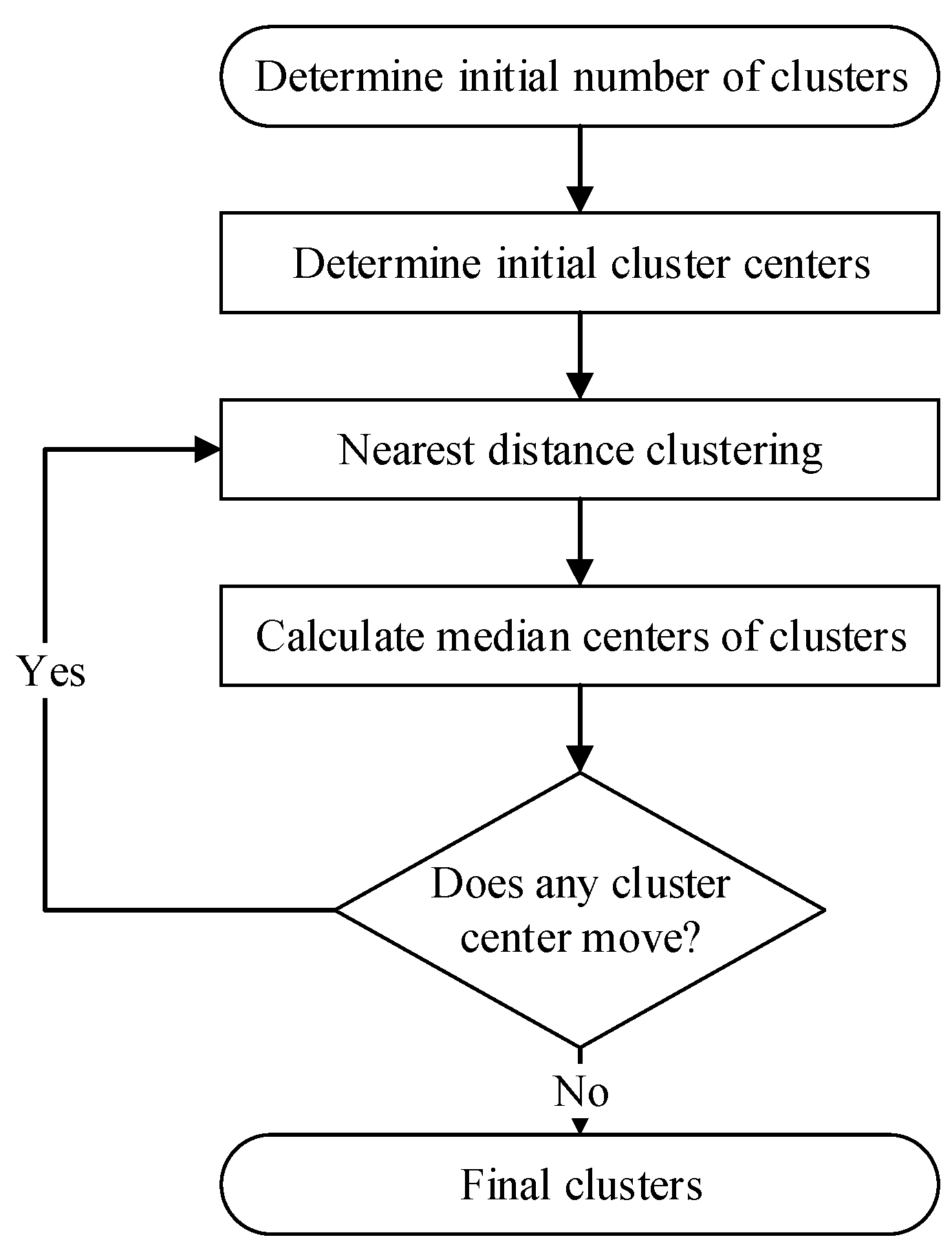
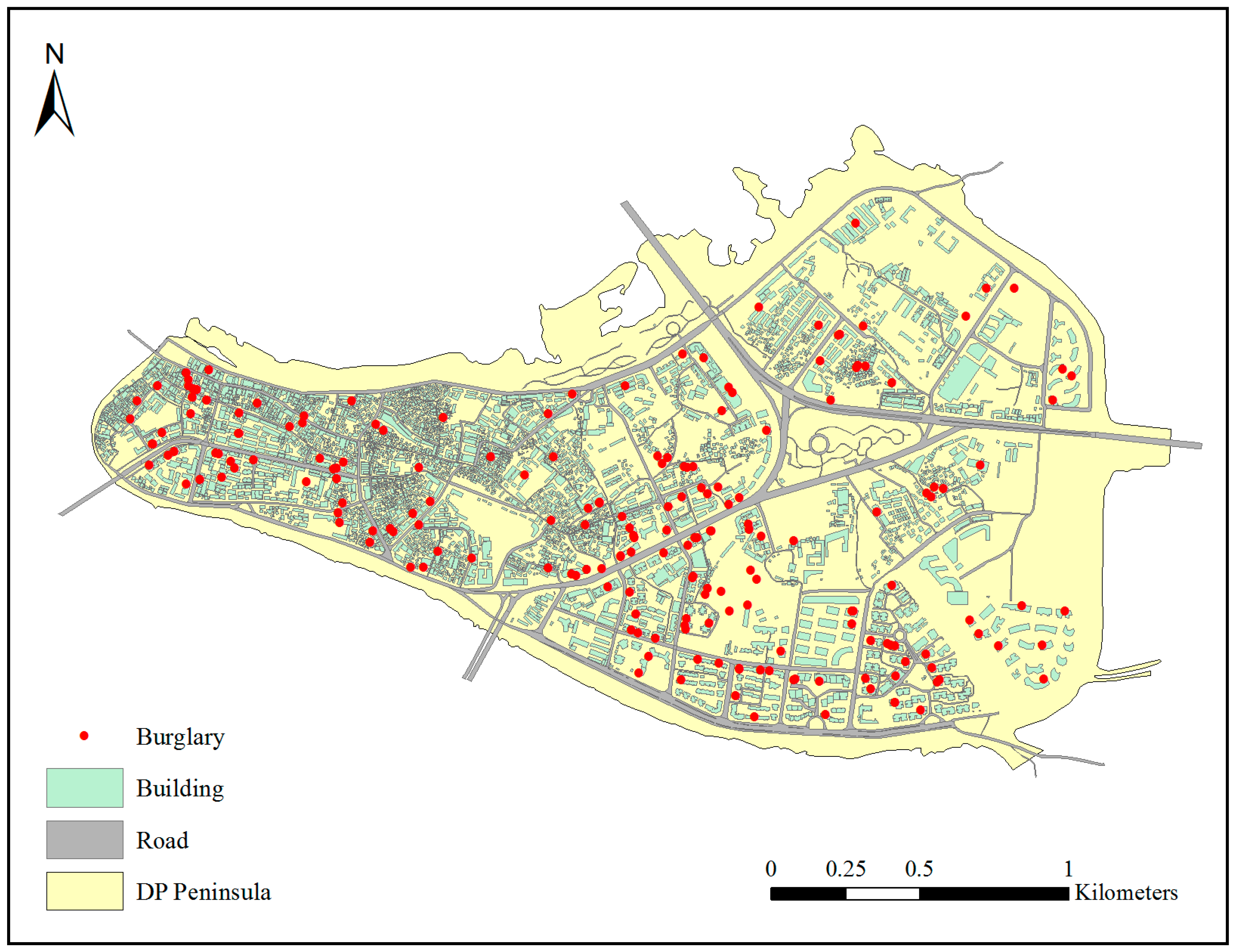
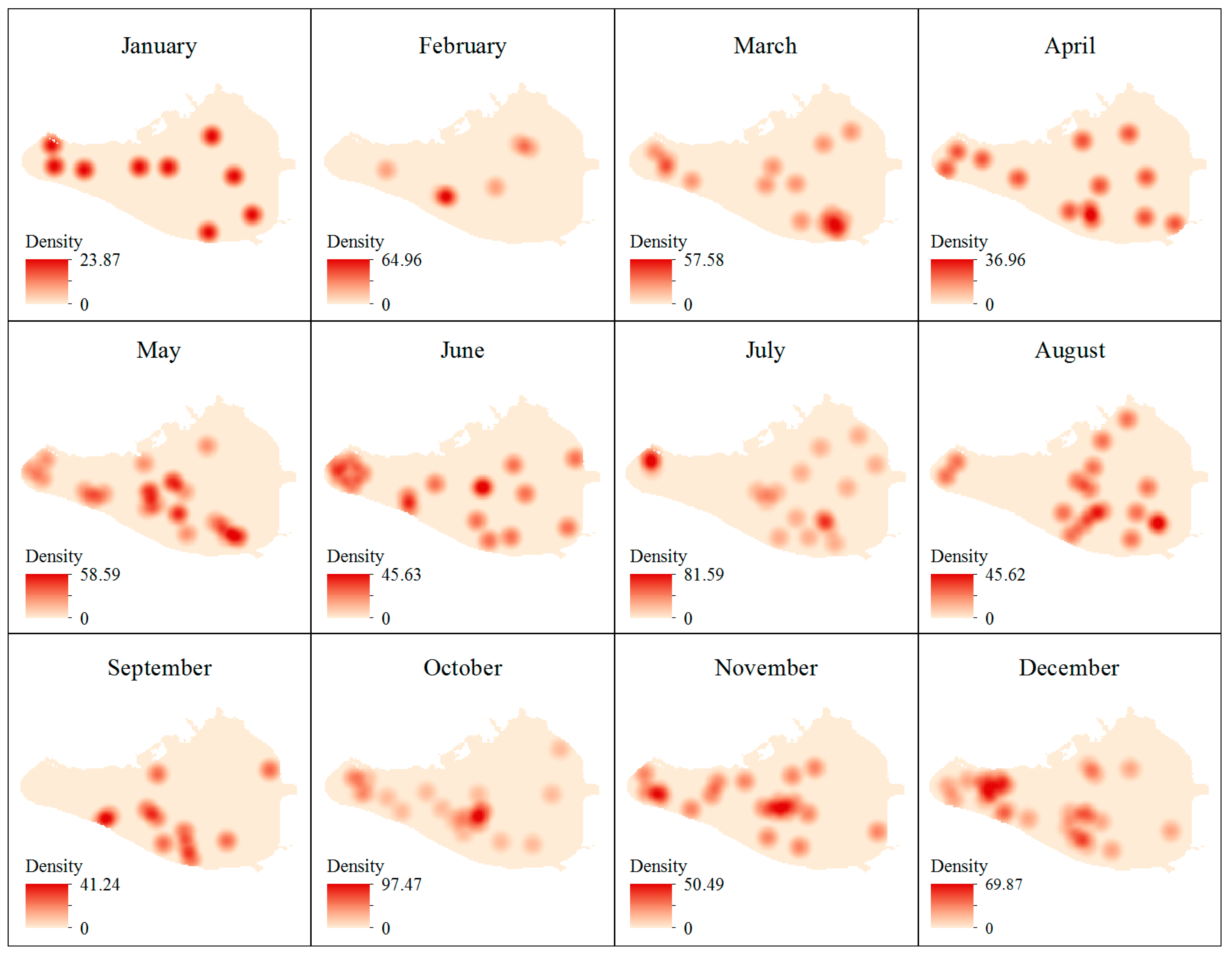

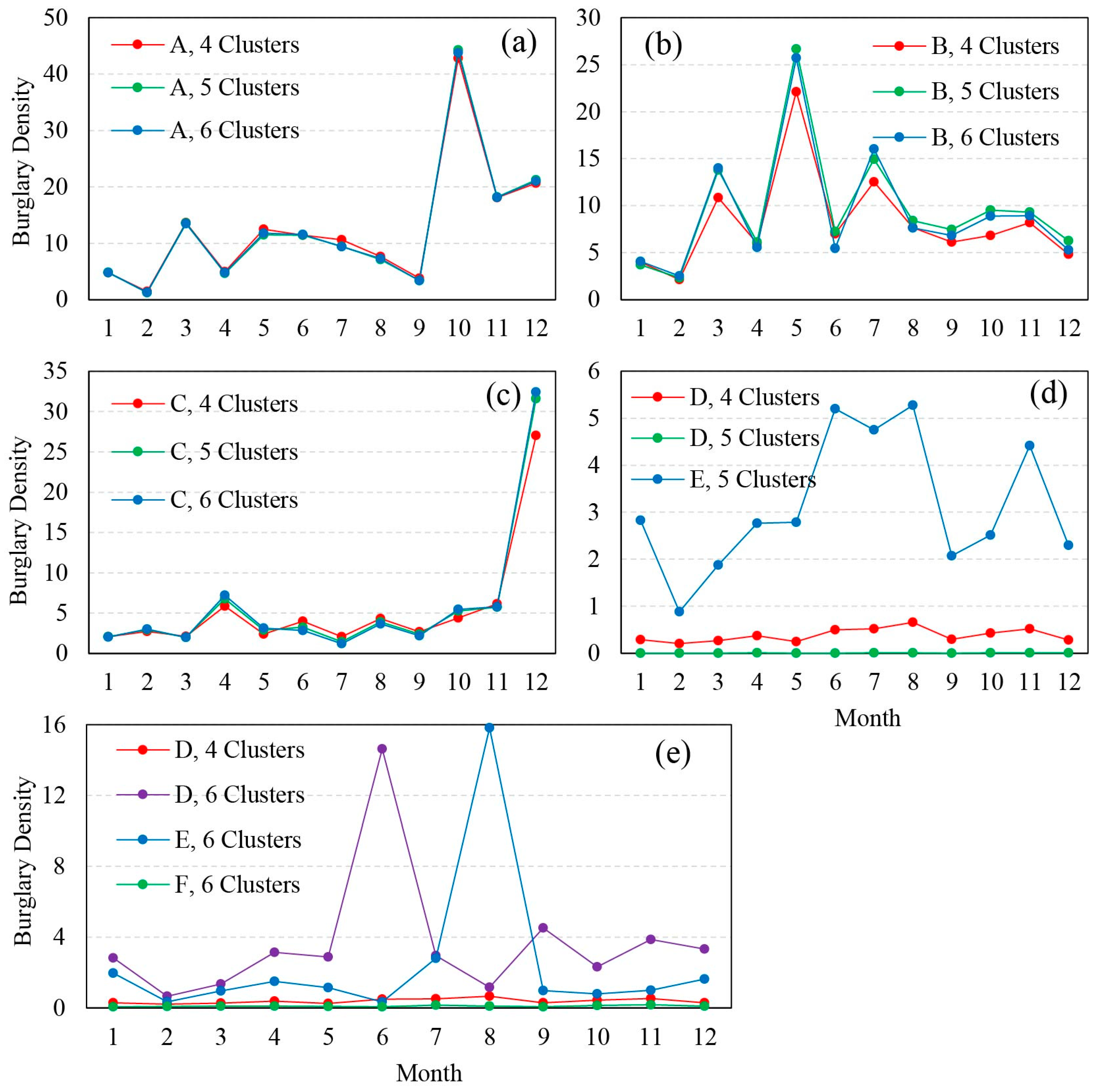
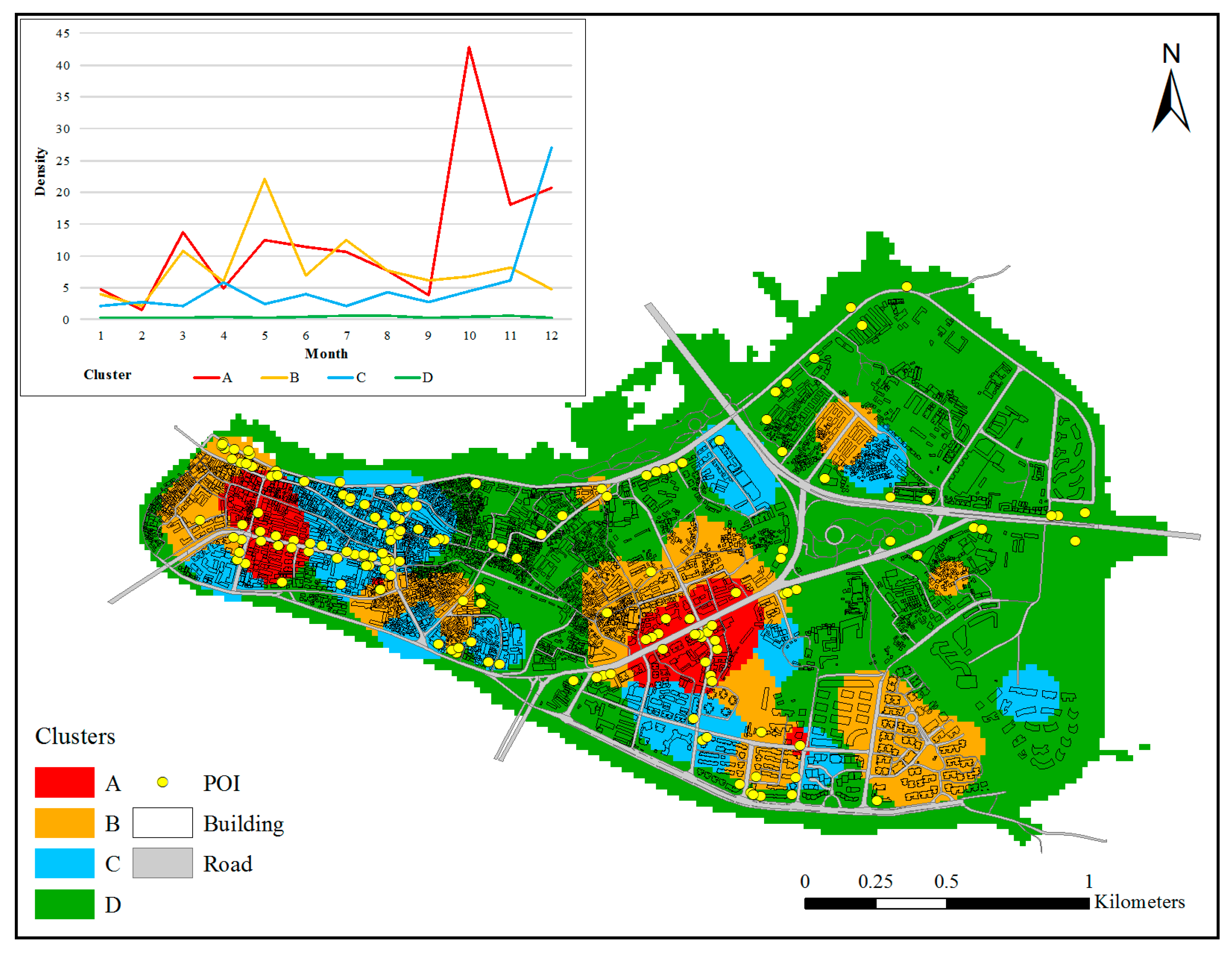
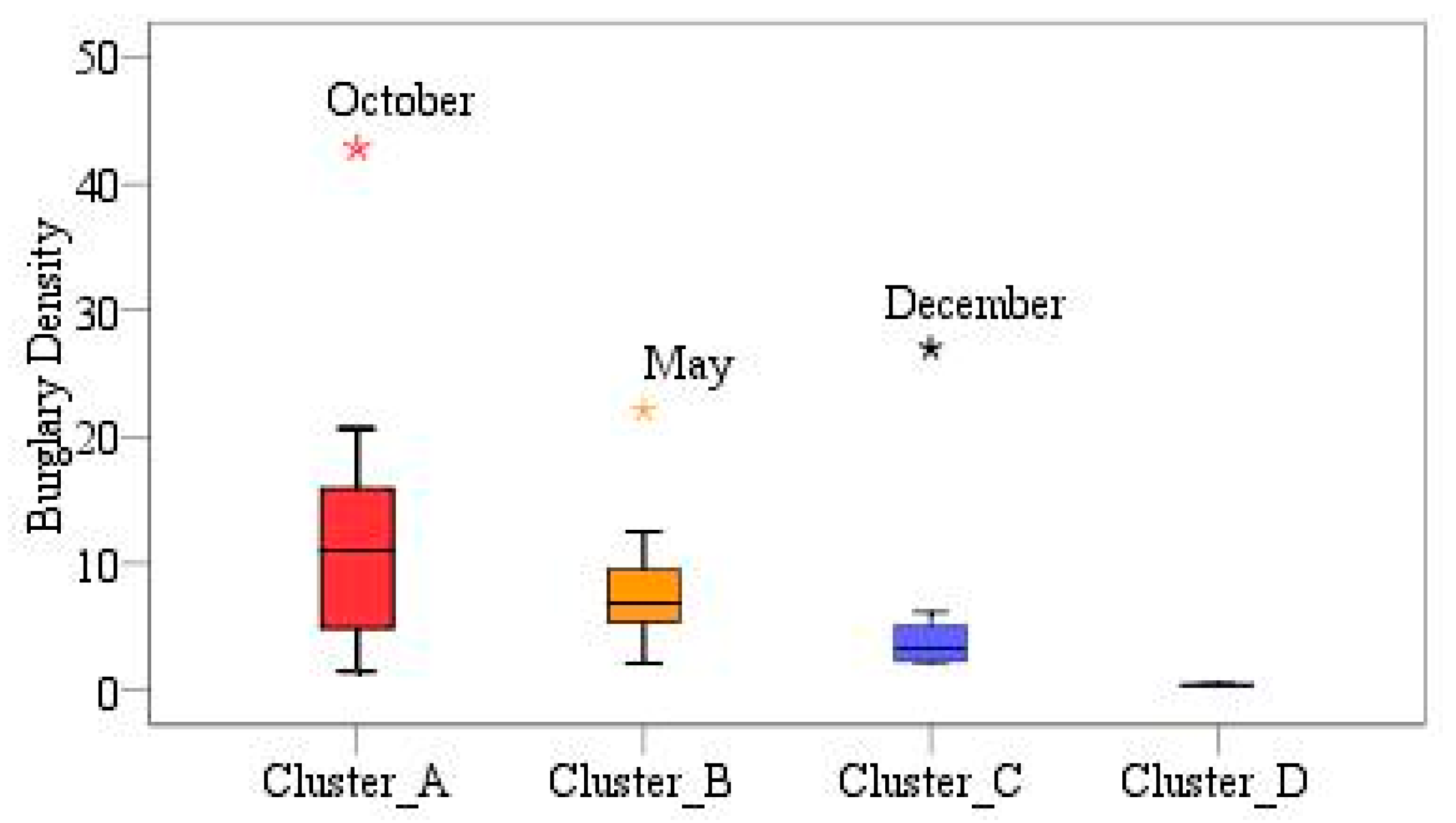




| 4 Clusters | 5 Clusters | 6 Clusters |
|---|---|---|
| Cluster A | Remains similar spatial-temporally | |
| Cluster B | Remains similar spatial-temporally | |
| Cluster C | Remains similar spatial-temporally | |
| Cluster D |
|
|
| Equation | (p-Value) | (p-Value) | (p-Value) | Adjusted | Durbin-Watson |
|---|---|---|---|---|---|
| (6) | 43.316 (<0.001) | 0.010 (<0.001) | 0.319 (<0.001) | 0.202 | 1.976 |
| (7) | −14.303 (<0.001) | 0.170 (<0.001) | −0.002 (0.925) | 0.595 | 1.960 |
Publisher’s Note: MDPI stays neutral with regard to jurisdictional claims in published maps and institutional affiliations. |
© 2021 by the authors. Licensee MDPI, Basel, Switzerland. This article is an open access article distributed under the terms and conditions of the Creative Commons Attribution (CC BY) license (http://creativecommons.org/licenses/by/4.0/).
Share and Cite
Jiang, C.; Liu, L.; Qin, X.; Zhou, S.; Liu, K. Discovering Spatial-Temporal Indication of Crime Association (STICA). ISPRS Int. J. Geo-Inf. 2021, 10, 67. https://doi.org/10.3390/ijgi10020067
Jiang C, Liu L, Qin X, Zhou S, Liu K. Discovering Spatial-Temporal Indication of Crime Association (STICA). ISPRS International Journal of Geo-Information. 2021; 10(2):67. https://doi.org/10.3390/ijgi10020067
Chicago/Turabian StyleJiang, Chao, Lin Liu, Xiaoxing Qin, Suhong Zhou, and Kai Liu. 2021. "Discovering Spatial-Temporal Indication of Crime Association (STICA)" ISPRS International Journal of Geo-Information 10, no. 2: 67. https://doi.org/10.3390/ijgi10020067
APA StyleJiang, C., Liu, L., Qin, X., Zhou, S., & Liu, K. (2021). Discovering Spatial-Temporal Indication of Crime Association (STICA). ISPRS International Journal of Geo-Information, 10(2), 67. https://doi.org/10.3390/ijgi10020067










